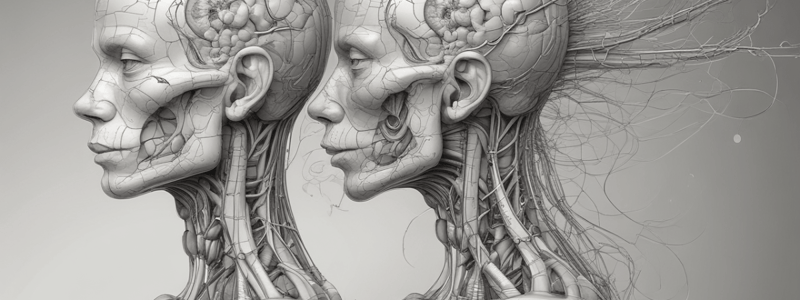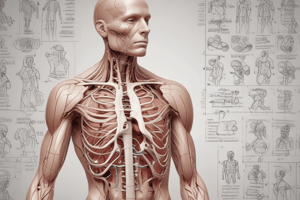Podcast
Questions and Answers
Which of the following levels of organization represents the most basic and fundamental unit of life?
Which of the following levels of organization represents the most basic and fundamental unit of life?
- Cellular level (correct)
- Organ level
- Chemical level
- Tissue level
What is the primary focus of physiology?
What is the primary focus of physiology?
- Analyzing how the body's organs, tissues, and cells work together to maintain life (correct)
- Explaining how diseases affect the body's normal functions
- Identifying and describing the structures of the body
- Understanding the malfunctioning of the body's systems
Which of the following is an example of how anatomy and physiology are interconnected?
Which of the following is an example of how anatomy and physiology are interconnected?
- Inflammation is a response to tissue injury
- A broken bone can lead to impaired mobility
- Heart failure causes fluid retention in the body
- The shape of the lungs allows for efficient gas exchange (correct)
Which field of study investigates the reasons behind a malfunctioning heart in a patient with heart failure?
Which field of study investigates the reasons behind a malfunctioning heart in a patient with heart failure?
Which of the following BEST describes the relationship between anatomy and pathophysiology?
Which of the following BEST describes the relationship between anatomy and pathophysiology?
How does the study of pathophysiology contribute to healthcare practices?
How does the study of pathophysiology contribute to healthcare practices?
Which of the following is NOT a level of organization within the human body?
Which of the following is NOT a level of organization within the human body?
What is the difference between a tissue and an organ?
What is the difference between a tissue and an organ?
Flashcards are hidden until you start studying
Study Notes
Anatomy, Physiology, and Pathophysiology
- Anatomy is the study of the body's structures, including organs, bones, muscles, and tissues, and involves identifying and describing their various parts.
- Example: The heart is a muscular organ located in the chest, responsible for pumping blood throughout the body.
Physiology
- Physiology is the study of the functions of the body's structures, explaining how organs, tissues, and cells work together to maintain life.
- Example: The heart functions to pump blood, carrying oxygen and nutrients to the body's cells.
Pathophysiology
- Pathophysiology is the study of the malfunctioning of normal chemical, physical, or mechanical functions of the human body due to disease.
- It explains how diseases affect the body's normal functions, such as heart failure, where the heart is unable to pump blood effectively, leading to symptoms like shortness of breath and fluid retention.
Levels of Organization in the Human Body
- Chemical level: the smallest level, consisting of individual atoms and molecules.
- Cellular level: the level of individual cells, the basic units of life.
- Tissue level: the level of groups of similar cells working together to perform specific functions.
- Organ level: the level of individual organs, made up of tissues, performing specific functions.
- Organ system level: the level of groups of organs working together to perform specific functions.
- Organism level: the level of the entire human body, made up of organ systems.
Example of Levels of Organization
- The heart is an organ made up of cardiac muscle tissue, a type of tissue.
- The heart is part of the cardiovascular system, an organ system that includes the heart, blood vessels, and blood.
- The cardiovascular system is responsible for circulating blood throughout the body.
Studying That Suits You
Use AI to generate personalized quizzes and flashcards to suit your learning preferences.




